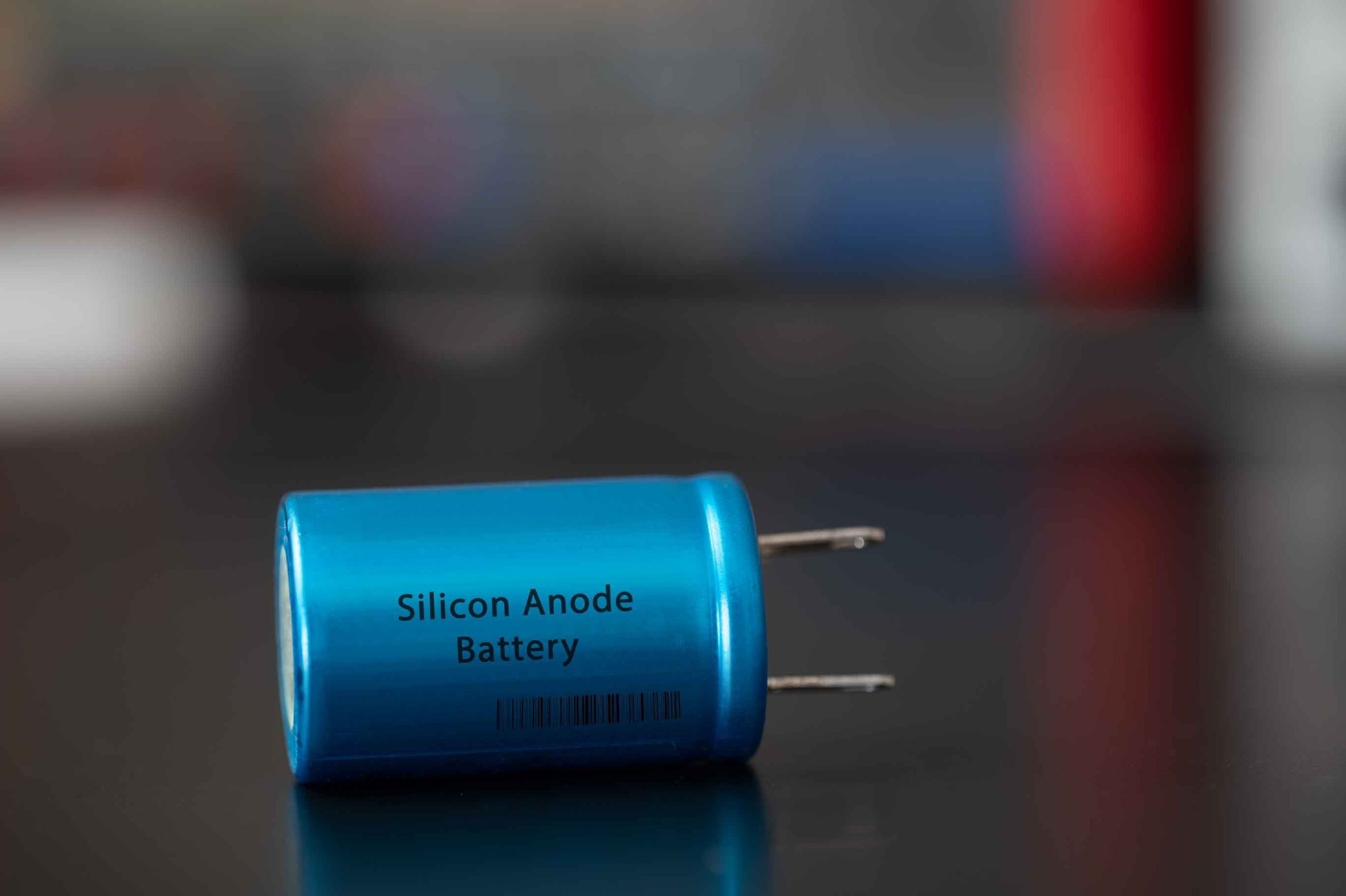 By JanakyReviewed by Lexie CornerAug 20 2024
By JanakyReviewed by Lexie CornerAug 20 2024Secondary batteries are essential for meeting the growing energy storage needs in mobile devices, electric vehicles, and renewable energy systems. This demand can only be met with batteries that offer high energy density, long cycle life, high safety, and high power density.1

Image Credit: luchschenF/Shutterstock.com
Lithium-ion batteries are the most popular secondary batteries for these applications, and silicon is widely regarded as the best anode material for lithium-ion batteries, particularly solid-state silicon batteries or silicon-anode all-solid-state batteries.
Silicon can accommodate up to four lithium ions per silicon atom, resulting in an exceptionally high capacity.2 With a low electrochemical potential similar to graphite, silicon is abundant, lightweight, and environmentally friendly.
What is a Silicon Anode?
A rechargeable lithium-ion battery comprises two electrodes (anode and cathode), an electrolyte, a separator, and current collectors for positive and negative charges.2
The separator and the electrolyte together enable the movement of positively charged lithium ions between the electrodes. This ion movement generates free electrons in the anode, which produce a charge at the positive current collector. The separator also blocks the direct movement of electrons inside the battery. This flow is reversed during the discharge process.2
Electrode materials for the negative electrode include intercalation materials, conversion materials, and alloys.3 Silicon batteries fall into the third category, where lithiation occurs through alloying between lithium and the electrode material.3 This alloying process offers higher lithium storage capacity than intercalation or conversion reactions, making alloys particularly promising materials.
LixSi alloys have been extensively studied, and at high temperatures (around 415 °C), four LixSi phases can be formed electrochemically.3 The first three phases—Li12Si7, Li7Si3, and Li13Si4— are well-established, though there is ongoing debate about the lithium-richest phase.3 Recently, other lithium-rich phases, Li17Si4 and Li21Si5, have also been synthesized.
Advantages and Challenges of Silicon Anodes
Silicon is a highly favorable anode material due to its ability to store up to ten times more lithium ions by weight compared to graphite.2 Notably, silicon’s potential as an anode material was recognized seven years before graphite became the standard.4
This significant capacity advantage translates into much higher energy density, making silicon an attractive option for applications requiring increased energy storage, such as electric vehicles and portable electronics.
Additionally, silicon is the second most abundant element on Earth, contributing to its environmental friendliness and relatively low cost, supporting the sustainable growth of lithium-ion batteries.2
Despite these advantages, several challenges impede the widespread adoption of silicon anodes. One major issue is the significant volume expansion of silicon during lithiation, which can reach up to 300-400 %.5 This expansion causes mechanical strain, leading to pulverization and deterioration of the electrode structure, ultimately reducing the battery's capacity and lifespan.
Another challenge is the formation of an unstable solid electrolyte interface (SEI) layer due to the large volume changes during the cycling of silicon anodes. This instability causes the SEI to continuously crack and reform, consuming lithium and electrolyte, which decreases efficiency and increases battery impedance.2
Furthermore, the performance of silicon anodes is limited by their low electronic conductivity and poor lithium-ion diffusion, especially in applications that demand rapid charge and discharge rates.3
While techniques such as doping and adding conductive additives have shown promise in improving these properties, they have not fully resolved the issues. Silicon anodes also suffer from low initial Coulombic efficiency, typically ranging from 60-80 %, due to irreversible lithium consumption during SEI formation and other side reactions with the electrolyte.2 This results in significant capacity loss during the initial cycles, impacting the overall efficiency and cycle life of the battery.
Recent Advancements in Silicon Anode Technology
Silicon, like carbon, can form a variety of allotropes, such as silicene, nanotubes, and nanowires. These nanostructures offer promising solutions to the volume expansion problem that occurs during lithiation and delithiation, a major challenge in conventional silicon anodes that often leads to mechanical failure.6
Silicene stands out due to its semimetallic properties and unique buckled hexagonal structure, which allows for a tunable bandgap through strain or doping, offering a promising route for enhancing silicon anode performance.7
Allowing strain relaxation in these nanostructures helps mitigate the risk of SEI fracturing.8 However, certain advanced nanoscale silicon structures, such as nanowires and nanotubes, have demonstrated high and stable cycling performance above 1000 mAh/g.
While these approaches address volume expansion and related issues, they do not resolve the problems associated with silicon's poor electronic conductivity.
Challenges such as initial Coulombic efficiency (ICE), areal capacity, and material cost remain significant hurdles for practical applications. In some cases, certain nanostructures could even reduce the battery's storage capacity.9
Structural modifications, including porous structures, core-shell designs with carbon or graphene coatings, and double core-shell configurations, are being explored to mitigate volume expansion and improve Coulombic efficiency and cyclic stability.
Academic and Industrial Research in Silicon Anode Technology
Contributions from both academic and industry researchers have driven significant progress in silicon anode technology. Recent advances in characterization techniques have provided deeper insights into the degradation mechanisms and electrochemical behaviors of silicon anodes.
Researchers are focusing on integrating binders, composites, and liquid electrolytes to further enhance the Coulombic efficiency and extend the lifespan of silicon anodes, bringing them closer to practical use.5 A paper in Advanced Energy Materials combines various studies that apply protective coatings, utilize nano-architectural designs, and engineer surfaces and interfaces to improve conductivity and stability..2
Researchers are also focusing on Sustainability, exploring methods to recycle silicon from photovoltaic waste, which could lower costs and enhance the environmental impact of silicon anodes.10
Further studies have delved into the stability of the SEI layer, which is essential for maintaining the performance of silicon anodes over time. In situ characterization and stress measurement techniques have provided valuable insights into the mechanical stresses and plastic deformation that silicon electrodes undergo during cycling, leading to new strategies for improving their durability.2
These combined efforts push silicon anodes closer to commercialization, making them a promising option for next-generation lithium-ion batteries.5 However, advanced research is still needed to address challenges such as nanostructuring and composite formation, which increase the complexity and cost of manufacturing, creating additional obstacles to the commercialization and broader adoption of silicon anode batteries.
More from AZoM: Comprehensive Overview of Physical Characterization Techniques for Lithium-Ion Battery Materials in R&D and Manufacturing
References and Further Reading
- Li, J., et al. (2017). Toward low-cost, high-energy density, and high-power density lithium-ion batteries. Jom. DOI: 10.1007/s11837-017-2404-9, https://link.springer.com/article/10.1007/S11837-017-2404-9
- Jin, Y., Zhu, B., Lu, Z., Liu, N., Zhu, J. (2017). Challenges and recent progress in the development of Si anodes for lithium‐ion battery. Advanced Energy Materials. DOI: 10.1002/aenm.201700715, https://onlinelibrary.wiley.com/doi/full/10.1002/aenm.201700715
- Ozanam, F., Rosso, M. (2016). Silicon as anode material for Li-ion batteries. Materials Science and Engineering: B.DOI: 10.1016/j.mseb.2016.04.016, https://www.sciencedirect.com/science/article/abs/pii/S0921510716300435
- Patel, K. (2023). A Non-Engineer’s Journey to IEEE Leadership. [Online] IEEE Spectrum. Available at: https://spectrum.ieee.org/non-engineers-journey-to-ieee
- Sun, L., Liu, Y., Shao, R., Wu, J., Jiang, R., Jin, Z. (2022). Recent progress and future perspective on practical silicon anode-based lithium-ion batteries. Energy Storage Materials. DOI: 10.1016/j.ensm.2022.01.042, https://www.sciencedirect.com/science/article/abs/pii/S2405829722000496
- Zhang, C., Wang, F., Han, J., Bai, S., Tan, J., Liu, J., Li, F. (2021). Challenges and recent progress on silicon‐based anode materials for next‐generation lithium‐ion batteries. Small Structures. DOI: 10.1002/sstr.202100009, https://onlinelibrary.wiley.com/doi/abs/10.1002/sstr.202100009
- Zhuang, J., Xu, X., Peleckis, G., Hao, W., Dou, S. X., Du, Y. (2017). Silicene: A promising anode for lithium‐ion batteries. Advanced materials. DOI: 10.1002/adma.201606716, https://onlinelibrary.wiley.com/doi/10.1002/adma.201606716
- Song, X., et al. (2024). Recent Developments in Silicon Anode Materials for High Performance Lithium-Ion Batteries. [Online] Merck KGaA. Available at: https://www.sigmaaldrich.com/IN/en/technical-documents/technical-article/materials-science-and-engineering/batteries-supercapacitors-and-fuel-cells/recent-developments-in-silicon-anode-materials
- Toki, GFI., Hossain, MK., Rehman, WU., Manj, RZA., Wang, L., Yang, J. (2024). Recent progress and challenges of silicon-based anode materials for lithium-ion batteries. Industrial Chemistry & Materials. DOI: 10.1039/D3IM00115F, https://pubs.rsc.org/en/content/articlelanding/2024
- Wang, F., Ma, L., Yuan, C. (2019). Experimental methods to study environmental sustainability of silicon-based lithium-ion battery manufacturing. Procedia Manufacturing. https://www.sciencedirect.com/science/article/pii/S2351978919305402
Disclaimer: The views expressed here are those of the author expressed in their private capacity and do not necessarily represent the views of AZoM.com Limited T/A AZoNetwork the owner and operator of this website. This disclaimer forms part of the Terms and conditions of use of this website.